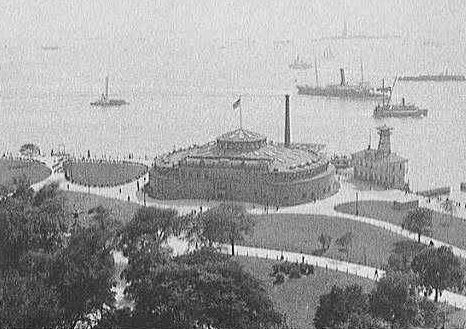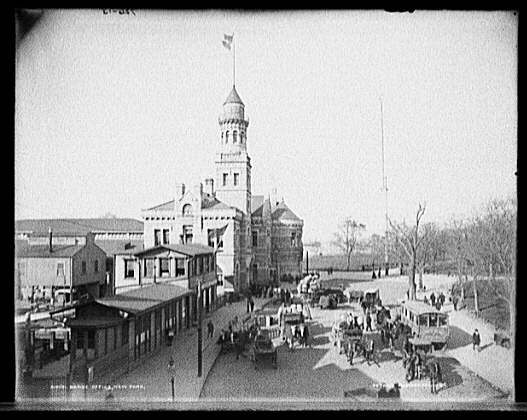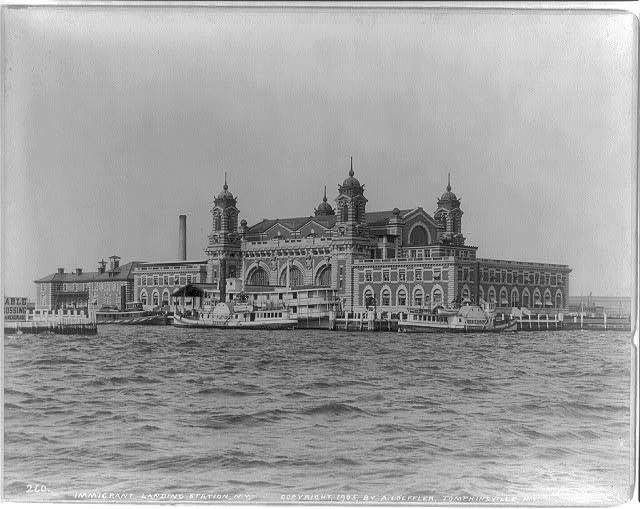ELLIS ISLAND GATEWAY TO THE AMERICAN DREAM
Ernesto R Milani, 16 January 2006 - Ecoistituto della Valle del Ticino - Cuggiono
Ellis Island and the Statues of Liberty next to it have meant the beginning of the American dream for millions of migrants in quest of a new life.
Actually this structure became operative effective January 1, 1892 January 1892 till November 1954 with a transit of over 12 million people.
Debarking on the American soil was practically free and little controlled until 1855.
There was no centralized office then and statistics were provided by the passengers manifests compiled by the clerks of the shipping companies. The growing numbers of migrants mostly Irish and Germans called for a statistic and sanitary control that was beyond the capability of the few port inspectors and migrant aid societies. The potato famine in Ireland and the new conditions imposed by industrial revolution had enormously augmented the number of migrants.
In 1850 the 200,000 migrants disembarked in New York were half Irish and the other half was mainly constituted by Germans. At this point the emergency was faced by using old Fort Clinton located at Battery Park on the southwestern tip of Manhattan as a screening station.
Effective August 1, 1855 and until April 18, 1890 over 70% of the migrants passed through Fort Clinton renamed Castle Garden and better known to the Italians as Castel Garden. In the course of
the years , the increase of migrants , the episodes of intolerance and exploitation towards the same , the federal government closed Castle Garden forever. After many vicissitudes it hosts the information center wherefrom depart the excursions to the Statue of Liberty and Ellis Island.
Rosa Cavalleri while narrating her experience as a migrant from Cuggiono to Marie Ets Hall in the book Rosa, Life of an Italian Immigrant, published by the Ecoistituto della Valle del Ticino of Cuggiono in 2003, highlights the drama of her first impact with the voyage and America, precisely at Castle Garden where she docked aboard La Normandie in 1887. Poignant imagines that would clearly remain in everybodyís mind in spite of the brevity of the experience.
"America.
The country where everyone could find work.
Where
wages were so high no one had to go hungry. Where all men were free and equal
and where even the poor could own land."
Docking in New York and then transfer by ferry to Castle Garden after a brief medical inspection.
"Doctors had come on the ship and ordered us inside to examine our eyes and our vaccinations. One old man couldnít talk and two girls with sore eyes were being sent back to the old country."
Trachoma was one of the diseases that forbid entry to America.
"Then one by one we went through a narrow door into Castle Garden.
The inside was a big, dark room full of dust, with fingers of light coming down from the ceiling. That room was already crowded with poor people from earlier boats sitting on benches and on railings and on the floor. And to one side were a few old tables where food was being sold.
Down the center between two railings high-up men were sitting on stools at high desks. And we had to walk in line between those two railings and pass them."
Rosa and her paesani had no problems. They went out, took their train tickets and the American money and proceeded to the exit where they found all they luggage.
Pending
a definite relocation the migrants were temporarily screened from April 18, 1890
till December 31, 1891 at the Barge Office situated on the southeastern tip of
Manhattan.
The general thought favored a new headquarter on one of the island of the bay of New York
With an easier transfer to New Jerseyís railway stations. New Jersey also wanted to get rid of the wastes of a gun powder magazine on an island close to its coasts.
And that's why after various suggestions the choice fell on Ellis Island.
Ellis Island thus became the place were millions of migrants were inspected before entering America.
Ships always called at New York.
Passengers holding an American passport and foreigners traveling in first or second class were checked on board and then disembarked freely.
In stead third class steerage passengers were transferred by ferry to Ellis Island.
Sometimes
they remained on board for two or three days waiting for the backlog at the
screening center to ease.
Itís easy to imagine the physical and mental conditions of this flood of people arriving after a fatiguing and painful voyage.
Rosa says:
"All us poor people had to go down through a hole to the bottom of the ship. There was a big dark room down there with rows of wooden shelves all around where we were going to sleep. the Italian, the German, the Polish, the Swedish, the French- every kind. And in that time the third class on the boat was not like now. The girls and women and the men had to sleep all together in the same room. The men and girls had to sleep even the same bed with only those little half-boardsup between to keep us from rolling together."
Rosa continues describing a storm that lasted for three days while they had to stay below deck with the door closed:
"We had no light and no air and everyone got sick where we were. We were like rats trapped in a hole, holding onto the posts and onto the iron frames to keep from rolling around."
Migrants arrived with the documents issued in their home country and a label with the information regarding the ship they arrived with. Beside the name of the migrant, the port of departure and the last place of residence.
The passenger lists of the ships were filled by the clerks of the shipping companies not by the inspectors of Ellis Island. Itís important to clarify this metropolitan legend regarding the changing of names at Ellis Island.
Actually while the ship clerks had to cope with passengers of different nationalities and little help, Ellis Island had a consistent number of interpreters for all ethnic groups.
Fiorello La Guardia was one of them while studying to become a lawyer taking advantage of his knowledge of Italian, English and Yiddish.
A difficult surname like Garavaglia became Garavaglia the Garvalia and even Garvali after naturalization while Scandroglio turned into Scandroli and Vanzaghi into Vansaghi.
Whenever the names were changed or misspelled at Ellis Island or by the ship clerks, it was the process of naturalization that determined or confirmed the new American name and surname according to the official documents possesses by the petitioner.
A first medical examination selected the people with deformities that requested further exams : their lapels were marked with chalk and sent to the hospital .
For example C stood for conjunctivitis, B for back, K for hernia, K for insanity and Ct for the feared trachoma. Holding their inspection cards with a reference number, the migrants , after waiting for entire days were eventually directed to the Registry Room for the proper individual check.
This was the most dreaded moment due to the great fear of being denied entry.
The shipping companies were obliged to verify the eligibility of the migrants to enter America.
This task was difficult since many migrants left Italy to board the ship from Le Havre in France and since they already held their tickets they could easily pass the French control.
The normal procedure to fine the carrier is still applied. In fact, the airlines are held responsible of the documentation of the passengers they transport to the USA regardless of the possible accuracy of the checks made. In case of infringements the airlines are fined without considering any extenuating circumstances.
The clerks had the job to ascertain whether migrants had a condemned disease or were liable to become a public charge.
The average number of denials was around 2 %. In 1907, the
Peak year of immigration, only 13,000 people were sent back home out of about 1,285,000 processed.
After the completion of all formalities, the migrants went down the Stairs of Separation where everybody went towards his or her destination. In spite of the various immigrantsí aid societies and at least from 1894 to 1900 of the Italian labor office managed by Alexander Oldrini and Egisto Rossi, on behalf of the Italian Embassy of Washington, the migrants were often at the mercy of swindlers, pimps, criminals working for the various padroni.
The dream road was studded with hurdles.
Rose keeps telling her first experience on arrival in New York :
"When the gate was opened men wearing badges came running in , going to the different people. One dressed-up man with a cane and waxed mustache came to us : -Buon giorno , paesani. Benvenuti. Welcome to America. Welcome to the new country.- He was speaking Italian and English too and putting out his hand to shake hands with Pep".
This guy volunteers to help them and after making sure that they
hold their train tickets and American money, he introduces himself as Bartini ( Bertini) and offer his service since he claims that the train for Missouri is due to leave only in three days and therefore they may stay at his hotel.
"And in three days he did put us on the train but he took all our money first, about thirteen dollars each one. He left us not even a crust of bread for our journey. And we didnít even guess he was fooling us."
Ellis Island was destroyed by a fire on June 14, 1897 and the Barge Office became operational again till December 16, 1900 when the new Ellis Island structure was inaugurated.
WWI changed Ellis Island that after 1917 became also a detention center for deportees and political
detainees. The gateway to the American dream was closing down.
After the Red Scare the number of people diminished sharply and the new immigration policies introduced in 1921 and 1924 reduced the role of the screening station.
During WWII American citizens of German. Japanese and also Italian descent were detained there.
Ellis Island closed its doors on November 12, 1954.
In 1965 President Lyndon Johnson declared Ellis Island a National Monument.
Effective September 10, 1990 the main building has become the Ellis Island Immigration Museum.
A long history displayed in front of our eyes through the ship passenger manifests where we may join our ancestors and understand some of their history that is indeed also our history, too.
Greatest emigration countries: 1820-1978
|
Origin country |
Emigrants |
Percentage |
Peak (Year) |
|
Germany |
6.978.000 |
14.3 % |
1882 |
|
Italy |
5.294.000 |
10.9 % |
1907 |
|
England |
4.898.000 |
10.0 % |
1888 |
|
Irish |
4.723.000 |
9.7 % |
1851 |
|
Austria-Hungarian |
4.315.000 |
8.9 % |
1907 |
|
Canada |
4.105.000 |
8.4 % |
1924 |
|
Russia |
3.374.000 |
6.9 % |
1913 |
|
Scandinavia |
2.525.000 |
5.2 % |
1882 |